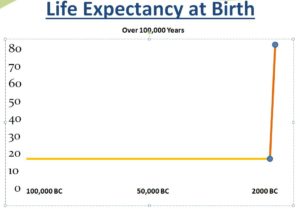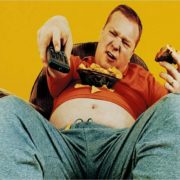It’s Time to Get Real About Our Lifestyle – It’s Killing Us!!
“Americans are retiring later, dying sooner and sicker in-between”
That’s the headline to an article published in the Standard-Examiner on October 23, 2017. My thanks to fellow re-invention coach, blogger and author John Tarnoff of Boomer Reinvention for posting it on LinkedIn.
According to the Society of Actuaries (who could argue with such an exciting group?), the meteoric rise in U.S. average life expectancy may have begun to recede. According to their research, age-adjusted mortality rate – a measure of the number of deaths per year – rose 1.2 percent from 2014 to 2015. That’s the first year-over-year increase since 2005, and only the second rise greater than 1 percent since 1980.
Maybe we shouldn’t be surprised. After all, over 100,000+ years, we increased from an average life expectancy of 18 (Neanderthal) to 30 (Roman centurion) to 47 (your great-great grandma) to 80 today. Graphically, that looks like this – in just 100 years, life expectancy increased more than in all of human history.

Graph source: Ken Dychtwald, Agewave.com
Don’t all good things have an endpoint?
While the article is a bit dismaying it’s far from revelatory. I’m inclined to invoke the overworked cliché “the chickens are coming home to roost”.
We’ve gotten really good at adopting lifestyles that are killing us slowly – and early.
Following our phenomenal success in stamping out myriad infectious diseases, throttling infant mortality, cleaning up our air and water, improving food and water quality and distribution and improving education, we now succeed in finding ways to kill ourselves early in the face of all that we know about how to do the opposite.
Bio-scientific and biomedical research of the last 30 years have provided us with more than we need to know to continue to extend our average life expectancy and move toward our full biological potential of 120+ years.
Discoveries of how our bodies and brains function, down to the cellular level, leave us with little excuse for not extending our lives – or to at least keep them healthier as we age. But we seem to persist in ignoring the surprisingly simple recommendations that emerge from the research.
A receding life expectancy is hand-in-hand with a number of errant lifestyle signals that are emerging. To wit:
- Eighty percent of American adults do not meet the government’s national physical activity recommendations for aerobic activity and muscle strengthening. Around 45 percent of adults are not sufficiently active to achieve health benefits. (Robert Wood Johnson Foundation).
- More than two-thirds (68.8 percent) of adults are considered to be overweight or obese. More than one-third (35.7 percent) of adults are considered to be obese. More than 1 in 20 (3 percent) have extreme obesity. Almost 3 in 4 men (74 percent) are considered to be overweight or obese.
- The American Diabetes Association reports that the number of people who have diabetes increased by 382 percent from 1988 to 2014.
- The CDC recently reported that as many as one-third of the U.S. population may be pre-diabetic and not know it.
- The weight of the average American increased by 15 pounds over the last 20 years – but we didn’t get any taller.

So what is a lazy, overweight, stressed-out, fast-food addict to do?
Nothing complicated, really. Actually, pretty simple. Not to be confused with easy. Difficult because it requires change and we don’t like change, especially the older we get.
How complicated is this health strategy?
- Lose weight. No, no – don’t diet. Diets don’t work. If they did, why would we spend $35 billion every year on the latest and greatest? Get the fat out and the plants in. Start there.
- Get your heart rate up into your exercise range every day. Simple formula: 220 minus your age times .65 and .85. That’s the range you should take your heart for at least 30 minutes a day, preferably six days a week. Sustained weight loss only comes when you combine diet and exercise. One without the other won’t get it done.
- Know your biomarkers. Get with your doc, get a thorough physical and find out – and understand – your key health bio-markers and where they should be and take corrective action if they are out of whack. What are the biomarkers? At a minimum, know where you are and where you should be with the following (most of these should come from pre-physical blood panels):
- Blood pressure
- HDL, LDL, triglycerides and total cholesterol
- Glucose (blood sugar)
- Uric acid
- Calcium, phosphorous, potassium and sodium
- Bilirubin, total protein, and albumin (liver function indicators)
- BUN (blood urea nitrogen) and creatinine – kidney function
- Waist size (under 40” or men, 35” for women)
- PSA (men)
- TSH (thyroid stimulating hormone)
- Homocysteine (amino acid associated with vascular disease, Alzheimer’s, colon cancer and osteoporosis
- C-reactive protein – related to inflammation

- Reduce the stress in your life. The CDC claims that 90% of doctor’s visits are, in some ways, related to problems brought on by stress. Stress releases harmful chemicals from our endocrine system such as cortisol and adrenaline. That system evolved to protect us from saber-toothed tigers and warring clans. Unless you still have those in your life (or equivalents), seriously consider finding ways to stop the release of those harmful, insidious chemicals. What works:
- Meditation/mindfulness – get alone with your breathing for 15 minutes a day, and periodically throughout the day as stress builds
- Exercise – surprise, surprise. Hands down the best stress reliever. A twofer – stress relief and a better circulatory system and physique.
- Stop comparing – comparison to others or temporal standards creates stress. Keeping up with the Joneses is a life-shortener. Find out who you really are and be it. Build your own dreams, not somebody else’s.
We can be better than this!
Our lack of health care literacy, laziness, and capitulation to convenience sustains the $35 billion diet and the $26 billion health and fitness club industries year after year. Both see a big surge in revenue at the beginning of each year. They know its coming and they know the surge will wane and circle back around again the next year. They are both business models built on our naivete and inability to discipline ourselves.
There’s another industry – in fact, the largest on the planet – that thrives based on the same human behavior. That is our health-care –I’m sorry, our disease-care – system. It’s built on repair, not prevention. It doesn’t strive to turn off the spigot but rather to mop up the water, often when it’s too late. Pretty simple solutions – drug it or cut it out.
Would it be too “pollyannish” to propose we help disrupt all three industries by taking charge of our own health? Yeah, that’s a pretty radical, wasted thought. But, then again, is it? I’m trying to do my part. Hope you join me.
No doubt you have some opinions in this area. Leave me a comment, let me know your thoughts.





Great stats along with your great message! Thank you.pat